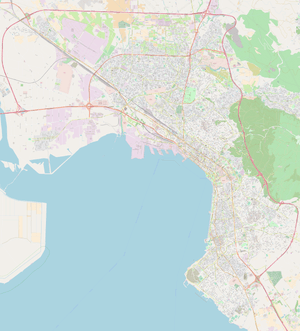Venizelou station
| ||||||||||||||||||||
|---|---|---|---|---|---|---|---|---|---|---|---|---|---|---|---|---|---|---|---|---|
| Location |
Thessaloniki Greece | |||||||||||||||||||
| Coordinates | 40°38′13″N 22°56′31″E / 40.63694°N 22.94194°ECoordinates: 40°38′13″N 22°56′31″E / 40.63694°N 22.94194°E | |||||||||||||||||||
| Owned by | Thessaloniki Metro | |||||||||||||||||||
| Line(s) |
| |||||||||||||||||||
| Platforms | 1 (island) | |||||||||||||||||||
| Tracks | 2 | |||||||||||||||||||
| Construction | ||||||||||||||||||||
| Disabled access | Yes | |||||||||||||||||||
| History | ||||||||||||||||||||
| Opening | 2021[1] | |||||||||||||||||||
| Electrified | Yes | |||||||||||||||||||
| Services | ||||||||||||||||||||
| ||||||||||||||||||||
| Location | ||||||||||||||||||||
  Venizelou Location within the Thessaloniki urban area | ||||||||||||||||||||
Venizelou (Greek: Βενιζέλου, literally Venizelos [Street])[2] is an under-construction metro station serving Thessaloniki Metro's Line 1 and Line 2. The station is named after Eleftherios Venizelos, Liberal Prime Minister of Greece. It is expected to enter service in 2021.[1] Construction of this station has been held back by major archaeological finds, and it is designated as a high-importance archaeological site by Attiko Metro, the company overseeing its construction.[3] At this station, Roman Thessaloniki's marble-clad and column-lined Decumanus Maximus (main east-west avenue), along with shops and houses, was found running along the route of the Via Egnatia (modern Egnatia Street) at 5.4 metres (18 ft) below ground level.[3][4]
The discovery was so major that it delayed the entire Metro project for years. A historian dubbed the discovery "the Byzantine Pompeii".[5] Attiko Metro wanted to disassemble the road and re-assemble it elsewhere, while the City Council wanted Attiko Metro to redesign its network to accommodate the discovery in situ. Ultimately the case reached Greece's Council of State and Attiko Metro re-designed the metro line, sinking the tunnels to a depth ranging from 14 metres (46 ft) to 31 metres (102 ft), and making provisions for mini museums within the metro stations, similar to those of Athens Metro stations like Syntagma, which houses the Syntagma Metro Station Archaeological Collection.[3]
Venizelou station will also feature an open archaeological site, the first of its kind anywhere in a metro station, in order to maintain the road in its original location.[4] At the next station, Aghia Sofia, where the same road was unearthed (and where it is arguably more important, as a public square was found as well), the road will be disassembled and reassembled elsewhere.[4]
Venizelou station also appears in the 1988 Thessaloniki Metro proposal under the name Alkazar.[6] Alkazar is the popular name for Hamza Bey Mosque, a landmark on Egnatia and Venizelou streets.
References
- 1 2 "Θεσσαλονίκη: Νοέμβριο του 2020 παραδίδεται η 1η γραμμή μετρό Νέα Ελβετία-Συντριβάνι" [Thessaloniki: The 1st line from Nea Elvetia to Sintrivani will be opened in 2020]. www.iefimerida.gr (in Greek). 20 March 2018. Retrieved 13 August 2018.
- ↑ Attiko Metro A.E. "Thessaloniki Metro Lines Development Plan" (PDF). www.ametro.gr. Archived from the original (PDF) on 20 August 2018. Retrieved 20 August 2018.
- 1 2 3 Attiko Metro A.E. "Αρχαιολογικές ανασκαφές" [Archaeological excavations]. www.ametro.gr (in Greek). Retrieved 13 August 2018.
- 1 2 3 Skai TV. "Ιστορίες: Μετρό Θεσσαλονίκης" [Stories: Thessaloniki Metro]. www.skai.gr (in Greek). Retrieved 13 August 2018.
- ↑ Giorgos Christides (14 March 2013). "Thessaloniki metro: Ancient dilemma for modern Greece". www.bbc.co.uk. Retrieved 13 August 2018.
- ↑ "Κι όμως! Το ΜΕΤΡΟ Θεσσαλονίκης είναι έτοιμο (στα χαρτιά) από το 1987!" [It's true! The Thessaloniki Metro was ready (on paper) in 1987 already!]. www.karfitsa.gr (in Greek). Retrieved 13 August 2018.
See also